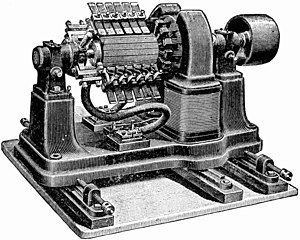The Dynamo was the first electrical generator capable of delivering power for industry. The dynamo uses electromagnetic principles to convert mechanical rotation into a pulsing direct electric current through the use of a commutator. The first dynamo was built by Hippolyte Pixii in 1832.
Through a series of accidental discoveries, the dynamo became the source of many later inventions, including the DC electric motor, the AC alternator, the AC synchronous motor, and the rotary converter.
A dynamo machine consists of a stationary structure, which provides a constant magnetic field, and a set of rotating windings which turn within that field. On small machines the constant

magnetic field may be provided by one or more permanent magnets; larger machines have the constant magnetic field provided by one or more electromagnets, which are usually called field coils.
Large power generation dynamos are now rarely seen due to the now nearly universal use of alternating current for power distribution and solid state electronic AC to DC power conversion. But before the principles of AC were discovered, very large direct-current dynamos were the only means of power generation and distribution. Now power generation dynamos are mostly a curiosity.



0 comments:
Post a Comment